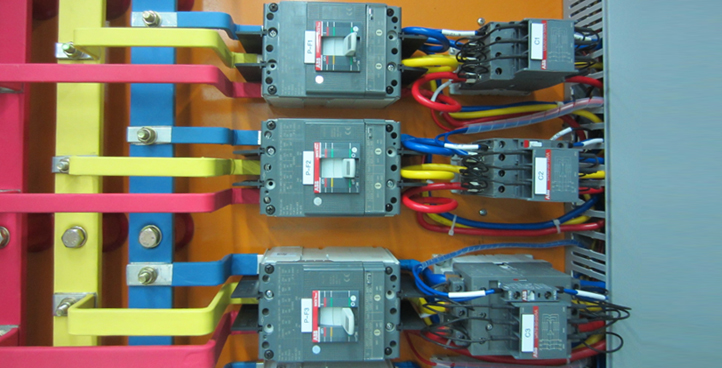POWER FACTOR CORRECTION PANELS In the realm of electrical systems, power factor correction panels play a crucial role in improving electrical efficiency, reducing energy costs, and ensuring the smooth operation of industrial and commercial facilities. Power factor is a measure of how effectively electrical power is utilized, and power factor correction panels are designed to mitigate power factor issues, resulting in enhanced system performance and financial savings. In this blog post, we will explore the significance of power factor correction panels, their functionalities, and how they contribute to optimizing electrical efficiency.
Understanding Power Factor:
Power factor is a measure of how effectively electrical power is utilized in an AC electrical system. It represents the ratio between real power (kW) and apparent power (kVA). A power factor of 1 indicates a system with purely resistive loads, where real power and apparent power are equal. However, in many industrial and commercial settings, power factor is less than 1 due to the presence of reactive loads, such as motors, transformers, and capacitors. Low power factor leads to increased current flow, higher energy losses, and reduced system efficiency.
Power Factor Correction Panels:
Power factor correction panels are electrical panels that house capacitors and associated control equipment. These panels are strategically installed to compensate for reactive power and improve power factor. Capacitor banks within the panels release reactive power, offsetting the reactive power drawn by inductive loads and reducing the overall system reactive power. By improving power factor, power factor correction panels optimize system efficiency, reduce energy losses, and enhance voltage stability.
Benefits of Power Factor Correction Panels:
a. Enhanced Energy Efficiency: Improving power factor through power factor correction panels minimizes the reactive power component and reduces energy losses in the electrical system. This results in more efficient utilization of electrical power and reduced energy consumption, leading to significant cost savings.
b. Demand Reduction: Low power factor can result in higher demand charges from utilities, as it requires the supply of additional current to compensate for reactive power. By correcting power factor, power factor correction panels help reduce demand charges, resulting in cost reductions on utility bills.
c. Voltage Stability: contribute to maintaining voltage stability in electrical systems. By reducing reactive power flow, these panels help alleviate voltage drops and fluctuations, ensuring equipment operates within optimal voltage ranges and minimizing the risk of damage or malfunction.
d. Extended Equipment Lifespan: mitigate excessive current flow caused by low power factor, reducing stress on electrical equipment. This extends the lifespan of motors, transformers, and other equipment, leading to lower maintenance costs and improved reliability.
Industrial and Commercial Applications:
find extensive application in various industries and commercial settings. Industries with inductive loads, such as manufacturing plants, data centers, hospitals, and shopping malls, can benefit significantly from power factor correction. These panels ensure efficient power distribution, reduce energy costs, and enhance the capacity of existing electrical infrastructure.
Automatic Power Factor Correction:
Many modernare equipped with automatic control systems. These systems continuously monitor power factor and adjust the capacitor banks accordingly. Automatic power factor correction ensures that the system maintains a near-unity power factor at all times, adapting to changing load conditions and optimizing power factor correction.
Conclusion:
play a vital role in optimizing electrical efficiency, reducing energy costs, and ensuring the smooth operation of industrial and commercial facilities. By mitigating power factor issues and compensating for reactive power, these panels enhance energy utilization, reduce losses, and improve voltage stability. Investing in is a sustainable and cost-effective solution that contributes to a more efficient and reliable electrical system, benefiting both the environment and the bottom line.
to watch ACB Panel click here.



